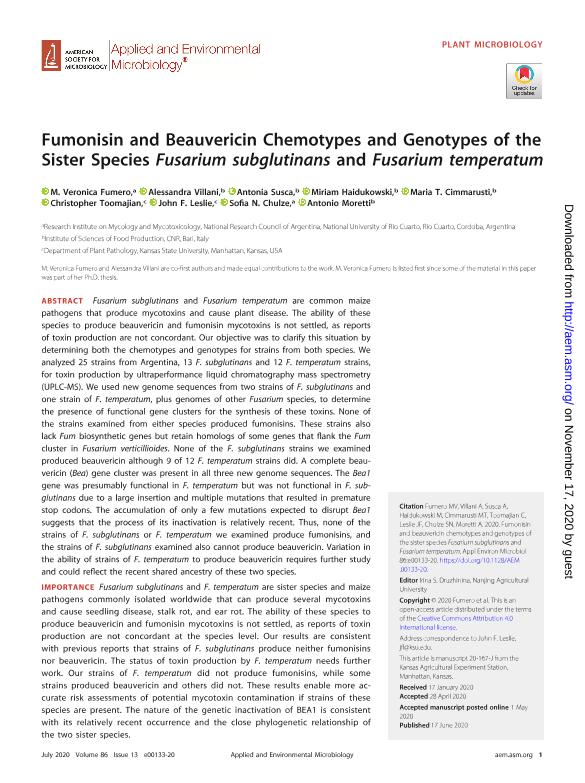Mostrar el registro sencillo del ítem
dc.contributor.author
Fumero, María Verónica

dc.contributor.author
Villani, Alessandra
dc.contributor.author
Susca, Antonia
dc.contributor.author
Haidukowski, Miriam
dc.contributor.author
Cimmarusti, María
dc.contributor.author
Toomajian, Christopher
dc.contributor.author
Leslie, John Franklin
dc.contributor.author
Chulze, Sofia Noemi

dc.contributor.author
Moretti, Antonio
dc.date.available
2021-03-04T17:38:12Z
dc.date.issued
2020-07-17
dc.identifier.citation
Fumero, María Verónica; Villani, Alessandra; Susca, Antonia; Haidukowski, Miriam; Cimmarusti, María; et al.; Fumonisin and beauvericin chemotypes and genotypes of the sister species Fusarium subglutinans and Fusarium temperatum; American Society for Microbiology; Applied and Environmental Microbiology; 86; 13; 17-7-2020; 1-15
dc.identifier.issn
0099-2240
dc.identifier.uri
http://hdl.handle.net/11336/127474
dc.description.abstract
Fusarium subglutinans and Fusarium temperatum are common maize pathogens that produce mycotoxins and cause plant disease. The ability of these species to produce beauvericin and fumonisin mycotoxins is not settled, as reports of toxin production are not concordant. Our objective was to clarify this situation by determining both the chemotypes and genotypes for strains from both species. We analyzed 25 strains from Argentina, 13 F. subglutinans and 12 F. temperatum strains, for toxin production by ultraperformance liquid chromatography mass spectrometry (UPLC-MS). We used new genome sequences from two strains of F. subglutinans and one strain of F. temperatum, plus genomes of other Fusarium species, to determine the presence of functional gene clusters for the synthesis of these toxins. None of the strains examined from either species produced fumonisins. These strains also lack Fum biosynthetic genes but retain homologs of some genes that flank the Fum cluster in Fusarium verticillioides. None of the F. subglutinans strains we examined produced beauvericin although 9 of 12 F. temperatum strains did. A complete beauvericin (Bea) gene cluster was present in all three new genome sequences. The Bea1 gene was presumably functional in F. temperatum but was not functional in F. subglutinans due to a large insertion and multiple mutations that resulted in premature stop codons. The accumulation of only a few mutations expected to disrupt Bea1 suggests that the process of its inactivation is relatively recent. Thus, none of the strains of F. subglutinans or F. temperatum we examined produce fumonisins, and the strains of F. subglutinans examined also cannot produce beauvericin. Variation in the ability of strains of F. temperatum to produce beauvericin requires further study and could reflect the recent shared ancestry of these two species.
dc.format
application/pdf
dc.language.iso
eng
dc.publisher
American Society for Microbiology

dc.rights
info:eu-repo/semantics/openAccess
dc.rights.uri
https://creativecommons.org/licenses/by/2.5/ar/
dc.subject
ARGENTINA
dc.subject
BEAUVERICIN
dc.subject
COMPARATIVE GENOMICS
dc.subject
FUMONISINS
dc.subject
FUSARIUM SUBGLUTINANS
dc.subject
FUSARIUM TEMPERATUM
dc.subject
GENE INACTIVATION
dc.subject
GENOME SEQUENCE
dc.subject
MAIZE PATHOGENS
dc.subject
MYCOTOXIN BIOSYNTHESIS
dc.subject
MYCOTOXINS
dc.subject
PLANT PATHOGENS
dc.subject
SECONDARY METABOLISM
dc.subject
UPLC-MS
dc.subject.classification
Micología

dc.subject.classification
Ciencias Biológicas

dc.subject.classification
CIENCIAS NATURALES Y EXACTAS

dc.title
Fumonisin and beauvericin chemotypes and genotypes of the sister species Fusarium subglutinans and Fusarium temperatum
dc.type
info:eu-repo/semantics/article
dc.type
info:ar-repo/semantics/artículo
dc.type
info:eu-repo/semantics/publishedVersion
dc.date.updated
2020-10-15T14:07:01Z
dc.journal.volume
86
dc.journal.number
13
dc.journal.pagination
1-15
dc.journal.pais
Estados Unidos

dc.description.fil
Fil: Fumero, María Verónica. Universidad Nacional de Río Cuarto. Facultad de Ciencias Exactas Fisicoquímicas y Naturales. Instituto de Investigación en Micología y Micotoxicología. - Consejo Nacional de Investigaciones Científicas y Técnicas. Centro Científico Tecnológico Conicet - Córdoba. Instituto de Investigación en Micología y Micotoxicología; Argentina
dc.description.fil
Fil: Villani, Alessandra. Institute of Sciences of Food Production; Italia
dc.description.fil
Fil: Susca, Antonia. Institute of Sciences of Food Production; Italia
dc.description.fil
Fil: Haidukowski, Miriam. Institute of Sciences of Food Production; Italia
dc.description.fil
Fil: Cimmarusti, María. Institute of Sciences of Food Production; Italia
dc.description.fil
Fil: Toomajian, Christopher. Kansas State University; Estados Unidos
dc.description.fil
Fil: Leslie, John Franklin. Kansas State University; Estados Unidos
dc.description.fil
Fil: Chulze, Sofia Noemi. Universidad Nacional de Río Cuarto. Facultad de Ciencias Exactas Fisicoquímicas y Naturales. Instituto de Investigación en Micología y Micotoxicología. - Consejo Nacional de Investigaciones Científicas y Técnicas. Centro Científico Tecnológico Conicet - Córdoba. Instituto de Investigación en Micología y Micotoxicología; Argentina
dc.description.fil
Fil: Moretti, Antonio. Institute of Sciences of Food Production; Italia
dc.journal.title
Applied and Environmental Microbiology

dc.relation.alternativeid
info:eu-repo/semantics/altIdentifier/url/http://aem.asm.org/lookup/doi/10.1128/AEM.00133-20
dc.relation.alternativeid
info:eu-repo/semantics/altIdentifier/doi/http://dx.doi.org/10.1128/AEM.00133-20
Archivos asociados
